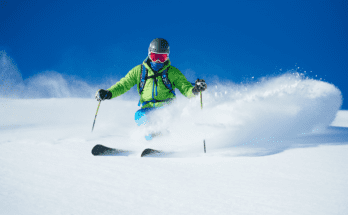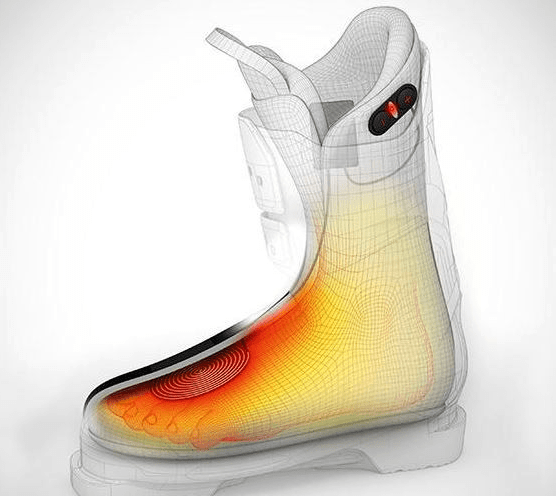Essential skiing equipment – what you do & don’t need
If you are skiing for the first time in your life or only going on a skiing holiday once a year, you do not necessarily need to buy a complete set of basic skiing equipment. You can quickly save lots of money, depending on your skiing style and your requirements. We’re going to run you through the ski equipment dos and donts to ensure you know what to take on your first ski trip.
The best time to buy ski equipment is in Spring, just before the end of the season. Even in the ski resorts, items from the previous season are then offered at considerably lower prices, so buy your ski equipment essentials then.
What you should definitely buy is the first layer that goes on your body. You can also use a few items of clothing that you already have in your wardrobe.
For example, yoga leggings are suitable as ski underwear. But the winter jacket you use for walking the dog is not necessarily ideal for a winter sporting activity.
It’s mainly up to you how you dress for your winter holiday. We have summarised what you urgently need, what you can borrow or take out of your wardrobe.
Ski clothing
Ski clothing is made up of several layers to keep you dry and warm at all times: the base, middle and top layers. It’s also good to have layers so that you can adjust as you are too hot or cold.
The base layer’s sole purpose is to absorb moisture when you sweat while skiing, so makes sure it is a breathable and absorbent fabric like merino wool.
Only use synthetic materials or special ski underwear made of wool, which is more expensive. You should pack two tops and two bottoms for your ski holiday so that one can dry and air out the next day from moisture wicking.
The middle layer is the warmth layer, and here you can confidently search your wardrobe. Fleece jackets or jumpers, thin cotton jumpers, wool jumpers or a special mid-layer down jacket are suitable.
You can wear two thin sweatshirts on top of each other, because the air between the layers is exactly what will keep you warm. So it’s better to wear more than one very thick jumper.
Two layers in total are usually enough for the legs, but if you stand a lot or it is extremely cold, we recommend insulated shorts. They keep the back and thighs, which tend to cool down in the lift, nice and warm.
The top layer, consisting of ski pants and ski jacket, must be weatherproof and breathable. Their job is to keep wind, snow, sleet and rain out while keeping the warmth in. Make sure the outer layer is at least 5,000 (5k) for waterproofing and breathability, while a higher rating of 10,000 (10k) and above is even more weatherproof.
The sky’s the limit when it comes to ski outerwear, but it is also the most important layer. You can borrow them from friends if you want to try skiing for the first time. Even if you only ski once a year, you could grab a good special offer online.
Some skiers pack several jackets and trousers for their ski holidays. But you don’t have to. One set is more than enough.
You can find detailed information on ski clothing in our blog entry “How to dress for skiing”.
Helmet, ski goggles, gloves and socks
For your own safety, please always ski with a helmet. Ski helmets not only look cool and keep your head sage, they also keep it nice and warm and dry.
As a beginner, you won’t be whizzing around the big slopes much yet, but someone can quickly overlook you and run you over. Please wear your helmet – always.
You don’t have to buy one right away; you can rent one at the ski rental shop. Don’t worry; you won’t be bothered with the hair and sweat of those before you. The helmets are cleaned and disinfected after each customer. If you want to play it absolutely safe, wear a thin cotton cap underneath.
You do not necessarily need ski goggles as a beginner, as the wind will not yet be so strong. You can just as well use your sunglasses on sunny days. If you are on higher mountains, ensure you have sufficient UV protection for your eyes, as the high UV radiation can be harmful.
Ski goggles are available very cheaply, or you can spend a few hundred euros if you have to. However, it is not necessary as long as they have good UV protection and some helpful anti-mist.
What you need to buy are some good gloves. But again, you shouldn’t buy professional models right away. A pair of cheap synthetic finger ski gloves will do just fine, as long as they are waterproof.
It would help if you didn’t use mittens for skiing, as they don’t give you as much feeling for your poles and make it much too challenging to use ski boot buckles and zips.
If your fingers get too cold, you can buy some mini hand warmers for the lift ride.
The next thing to buy is ski socks. You should not use your normal woollen socks or cotton socks as they can rub quickly. They hold the wetness, and you will get icy feet. If you have uncomfortable socks, the whole skiing experience is no fun.
Buy special ski socks that absorb moisture from your feet and keep you dry and warm. In addition, ski boot socks are designed not to slip.
Never put on two pairs of socks on top of each other, as this will only lead to pressure points. If you have the right socks, you won’t get cold feet. Otherwise, a ski boot heater can also help.
Take at least three pairs of ski socks with you. That way, you can wash the used ones by hand and let them dry while you wear the other pair the next day.
Skis and poles
If you book a ski course or activity through Skibro, you will get cheaper prices for ski rental on site. This not only saves you luggage, but you really save yourself a lot of money.
Ski rental doesn’t cost much, even for beginners. You will progress very quickly in the beginning, so you will quickly “outgrow” your beginner skis if you choose to buy them instead of renting. Buying expert skis right away is not a good idea at all.
Skis for different types of skiing and different skill levels make perfect sense. For example, beginner skis are much easier to turn on, while expert skis can be very hard and make you tilt quickly.
If you still want to have your own, buy second-hand ones. For as little as £100 you can get what you need to get started. The same goes for the poles.
Even if it is tempting to buy equipment from a friend, you must have the right length skis and poles. That’s why you should only buy from a specialist shop.
It can be really dangerous if you ignore the correct adjustment of the ski binding. If it is adjusted too lightly, it will loosen too quickly, and you will fall while skiing. If it’s too tight, it won’t open in a fall, and you can get seriously injured.
You should always seek advice from a professional for maximum fun and safety.
Ski boots and snow boots
It’s not everyone’s cup of tea to be in someone else’s boots all day. A good fit is also an important prerequisite for ultimate skiing fun.
You can, of course, hire the boots from the ski hire shop and don’t worry, they are also intensively cleaned and disinfected after each customer. The advantage is that you can exchange the ski boots should they not fit after day one.
However, if you want to buy boots, go back to a specialist shop. They will measure your feet and find the perfect boot for you. Ski boot manufacturers can even make the inner shoe especially for your feet, so that a perfect fit is guaranteed.
It’s advisable to bring some suitable shoes with you for after skiing, and snow boots are great for that so you don’t slip. Key to your feet staying warm too as the temperatures drop in the evening.
Our tip for ski boots and skis: Rent the ski gear or equipment for the first time. After a few days of skiing, you will know which is the best for you for next season and you can buy used or new models.




